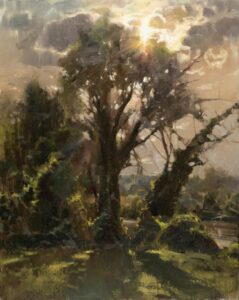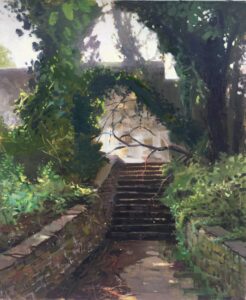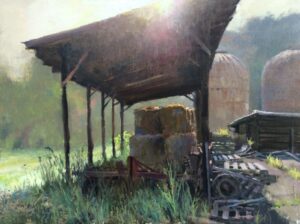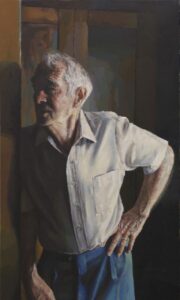 My son-in-law is Jason Sacran. That simple fact constitutes my one and only real connection to the art world. What follows are the confessions of a man who has had art thrust upon him, and has lived to tell about it.
My son-in-law is Jason Sacran. That simple fact constitutes my one and only real connection to the art world. What follows are the confessions of a man who has had art thrust upon him, and has lived to tell about it.
I am not an artist. I confess that right out of the gate. In fact, if you were to do a nationwide search to locate the individual who was least like a graphic artist, I might be your man. Drawing stick figures taxes my ability to the limit. So, when an aspiring young painter suddenly joined our family circle, I knew that I was going to have to enlarge the scope of my knowledge if I was to be able to carry on anything approaching an intelligent conversation with him about his field of endeavor.
I did know a few names, so I dropped them occasionally: Picasso, Rembrandt, American Gothic. I knew just enough to ask questions to make it sound like I knew more than I did: “Who do you think was the greatest of the Impressionist painters?” (I was fairly sure that Impressionist was a type of art and not the name of an artist, so I took the chance and tossed it into the conversation.) The problem with such opening lines is that after the line was opened, my expertise was closed. I was at a blank wall and could go no further. So . . . I determined that I needed to further my education in art.
At this point we need to drop back in time and fill in the background just a little bit. I live in rural west-central Arkansas, about an hour east of Fort Smith, the second-largest city in the state. Saying that this area is not exactly a hot-bed of artistic sentiment is one of the more profound statements I will ever make. If you have an interest in deer hunting, football and pick-up trucks, you could hardly come to a better place; but if you mention that you are a painter you are likely to be asked what you would charge to put a fresh coat on someone’s front porch. (In this area the correct pronunciation of wash is “worsh,” and ought is “ort.”) I am happy to say that my own family does have some artistic talent. My younger brother is a commercial artist and his daughter is amazingly talented in the field of ink drawings. However, my background and that of my parents is in music, and we did not venture at all into the graphic end of the art world. I taught school for a couple of years, decided I was not any good at it, and ended up working in the office at a corrugated box plant for 26 years. (Boxes do have flutes and flutes are shipped in boxes, but that is about as close as they get to the art world.)
I have six children: two boys, and then four girls. So, I have had The Conversation four times – the one about marrying my daughter. There was one question that I asked all four of the young men regarding the material support of my daughters: “Would you be willing to work a double shift at McDonald’s if that is what it took to keep food on the table?” All four answered in the affirmative, and I have to give them credit that they all are hard workers who have given me no concerns in that regard. However, if I had known then what I know now about the life of an artist, I might just have probed a little further.
You see, Jason and Rebekah got off to a very rough start. Leah, my third daughter (fifth child) got married in August, and right about then Rebekah announced that she was going to get married that November. I answered, “Oh, no you are not! not if you expect me to pay for it. Your mother just got through with a wedding, and she has all the holidays folderol just ahead, and she is having to help take care of your grandmother. You put it off at least until after the first of the year so she can catch her breath.” She relented and moved it out to January 8th.
It was cold on the day of the wedding, we had all that wedding pageantry right on the heels of the holidays, with Jason’s family coming in from Tennessee; and on top of it all, Jason got sick. I mean sick! (I will spare you the medical details.) He did not even attend the rehearsal. He was white as a sheet during the wedding. We had to tell him what he was supposed to do in the ceremony, and he could barely stand. They were going to stay at the Peabody Hotel in Memphis, and Jason was too sick to drive. Then they had a flat tire right about the intersection of Interstates 30 and 40 in North Little Rock. Jason could not change the tire because he had taken some medicine to help with his nausea and was completely out of it. We called someone we knew in the area to come help them.
Soon the children started arriving. Their first two daughters were born within a year of each other. (They are the same age for three days.) Two more followed very soon after that. Jason worked at the Art Center in Fort Smith for a while, taught a course or two at UAFS, and somehow they stayed afloat. In about five years, Jason decided that he wanted to try to make it strictly on his painting. It was at this point that the term “starving artist” began to pop into our consciousness. Oh, they made it, but most of the time just barely. Paint-outs all over the country, commissions, teaching seminars – any way and every way to keep their noses above water. And, of course, the bad thing about being a painter is that a) the income is not guaranteed, and b) it is not on any kind of a regular schedule. Trying to stay on a budget was well-nigh impossible for Rebekah. Occasionally we would loan them money against prize money that Jason had earned, but which was slow in arriving. Add to that the fact that Jason was on the road much of the time, which was stressful both for him and for Rebekah. I have seen it up close, and I assure you that it is not an easy way to make a living. You just hope and pray that the artist’s health and his wife’s sanity hold out. So far they have. (Those of you whose job it is to actually send out the prize money, please be prompt. Somewhere out there could be a father-in-law who is underwriting your award, and artists have to pay the light bill just like everyone else.) Things have gotten somewhat better in recent years, but it was quite “interesting” for a while, to say the least.
So, moving back to my education as a father-in-law: I needed to learn something about art, so I figured our family’s resident artist was the best place to learn. The first thing he taught me was not to be afraid to dislike one painting and to like another. That sounds simplistic, but you artsy folks might be amazed how intimidating it is for a landlubber like me to utter, for example, “I don’t think I care for van Gogh.” Still, Jason assured me it was OK not to like his work, so I hitched up my britches, stuck out my chest, and said it a little louder: “I don’t like van Gogh!” It felt pretty good, actually – sort of therapeutic. I, Mark Green, grandson of a Depression dirt farmer, have a firm opinion about something in the world of painting. I am somebody! Of course, then I had to come up with a positive opinion. “I do like much of Monet’s work, and I really like Rembrandt.” Believe it or not, even as hidebound and reactionary as I am, I do like a significant portion of abstract art.
I had nudged the bare tip of my nose above the surface of the art-lover’s pond. But why did I like Monet, and why did I not like van Gogh? Well, there you had me: I did not have the foggiest idea. So, Professor Sacran took me in hand and began to feed me little tidbits about what makes this a good painting and what makes that a bad painting. I learned, for example, that just because I say I do not like a painting does not mean that I am saying that it is a bad painting. It might be a great work, but simply one that does not appeal to me for whatever reason. In fact, he informed me (much to my dismay at the time) that van Gogh actually was a very skilled painter. That rocked me back on my heels for moment, but I rose heroically to the occasion: “I don’t care if he is great, I still don’t like him.” That really felt good.
Now began my training in earnest. Periodically I would visit Jason’s studio (which is in the small house where my grandparents lived, under the shadow of Mount Magazine, the tallest point in mid-North America). I would say that I liked this painting and did not like that one – right to his face. And he just smiled. I even developed the temerity to tell him that a particular painting of his was not finished and that he needed to go a little further with it. Jason was very gracious and patient and would act like my opinions actually carried some weight (age does have its privileges). And finally I arrived. I got to the point where I could look at one of his new paintings and say, “I really like this one because . . . ,” and have a valid reason.
I am not an art connoisseur, and never will be. I do not have the time to spend on such a project nor the inclination to spend it. At least, however, through the kindness and patience of the father of four of my eighteen grandchildren, I have reached the point where I can confidently say that I have a clue. I do not know all the answers, but at least I can ask a few intelligent questions.
One thing I have learned about painters: evidently the most important thing you can do to become famous is to die. Death somehow seems to improve a painter’s works exponentially. Now, the walls of my house are literally papered with genuine Sacrans (most of which I picked up at fire-sale prices through my father-in-law connection). But I am 64 years old, and I am not eager to get rid of my son-in-law just to jack up the prices of my art collection. I certainly hope that my daughter is not a widow within my lifetime. So, if I am going to make any sort of a profit from all these paintings before I kick the bucket, the rest of you folks are going to have to start buying them pretty soon in large quantities. Supply and demand, you know. All you supply-stokers out there, let’s get moving! I am not getting any younger. (Besides, this guy is really good; and you have that as the official opinion of a quasi-educated art-loving father-in-law.)
+++
Folks, laying levity aside for a moment, much of what I have said here concerning Jason is just as true of a multitude of aspiring young painters across the land. Theirs is not an easy lot. Even though some would term it foolishness, it does take a great deal of courage to launch out on a career of painting with no guarantees whatsoever of success. Where family responsibilities are attached, it doubles the risk – and the stress. Please give some consideration to purchasing a work by one of them. Who knows, you may be buying a canvas by the next Picasso. But even if he does not scale that lofty height, at least you would be doing a good deed in helping one of those whose goal is to bring visual beauty into our lives.
30×24, oil on linen panel,
Collection of Artist
24″ x 20″, oil on linen panel
Private Collection
18″ x 24″, oil on linen panel
Private Collection
Private Collection (Portrait of “Grandpa” Logan Green)
It has been a real pleasure getting to know my in-laws, the Greens, over the last thirteen years of my life. From the very go it seemed that I was destined to be a part of the family as they took me in and made me feel welcome from the start. In fact some of them have even become subjects of my paintings, especially, “Grandpa” the patriarch of the Green family. I would say for a time he was somewhat of a muse for me, having painted upwards of a dozen studies and significant paintings of him. His son, my father-in-law, Mark Green, has recently become a subject of a life painting since retiring from his job. He visits me at my studio sometimes and we talk shop and solve world problems. This is where the idea for this article came about. He asked if he could write an article about or for me since he had the time now that he’d retired. I, of course, replied in the affirmative, and he began throwing out possible topics. At some point I asked what he thought of me, as an artist, coming into his family and taking his daughter. I told him, I’d be curious to know what his thoughts were over the years in whatever way our interaction has played out thus far. Thank you for your story, Pappy (Mark).



